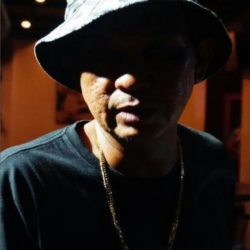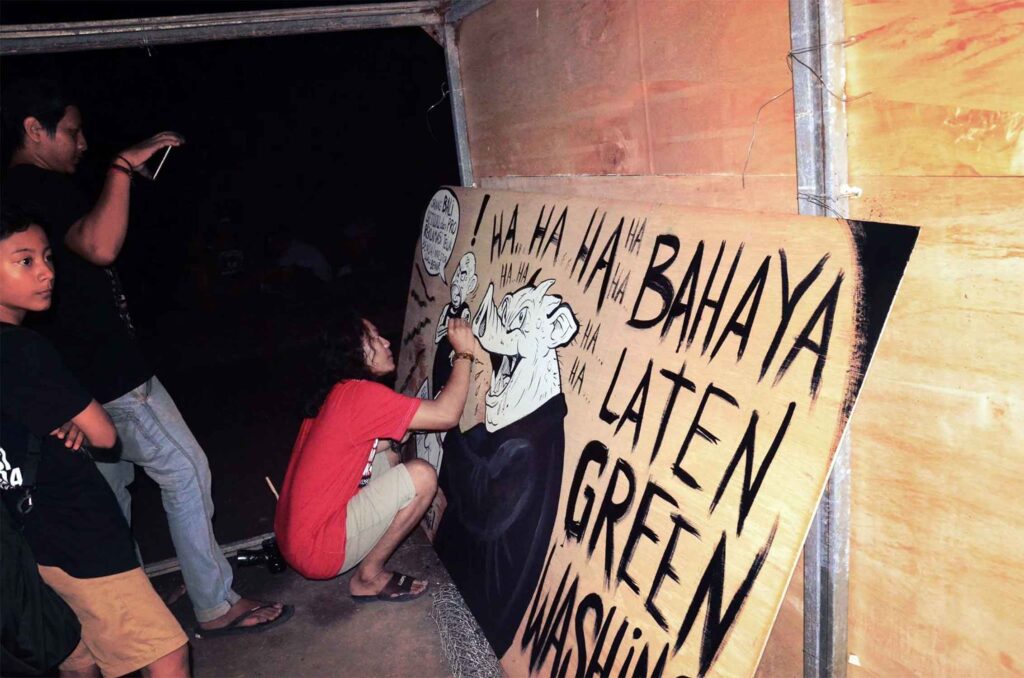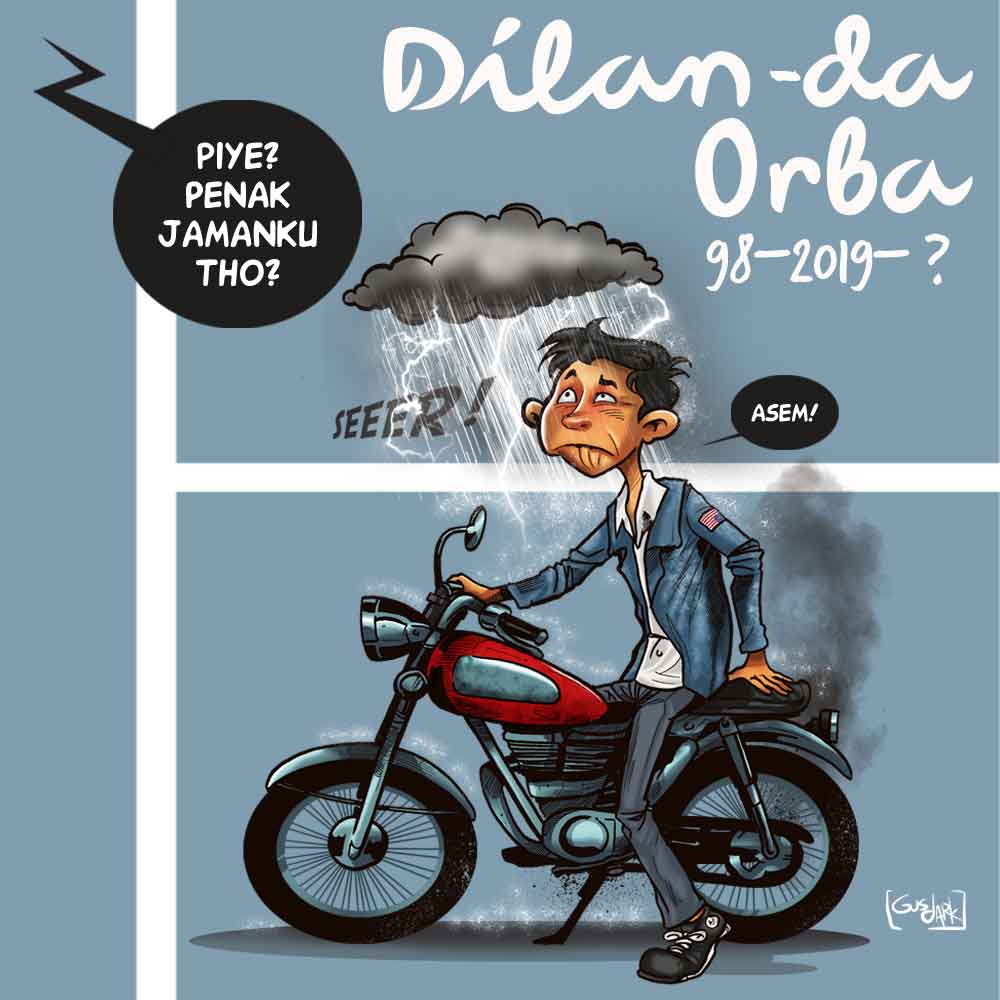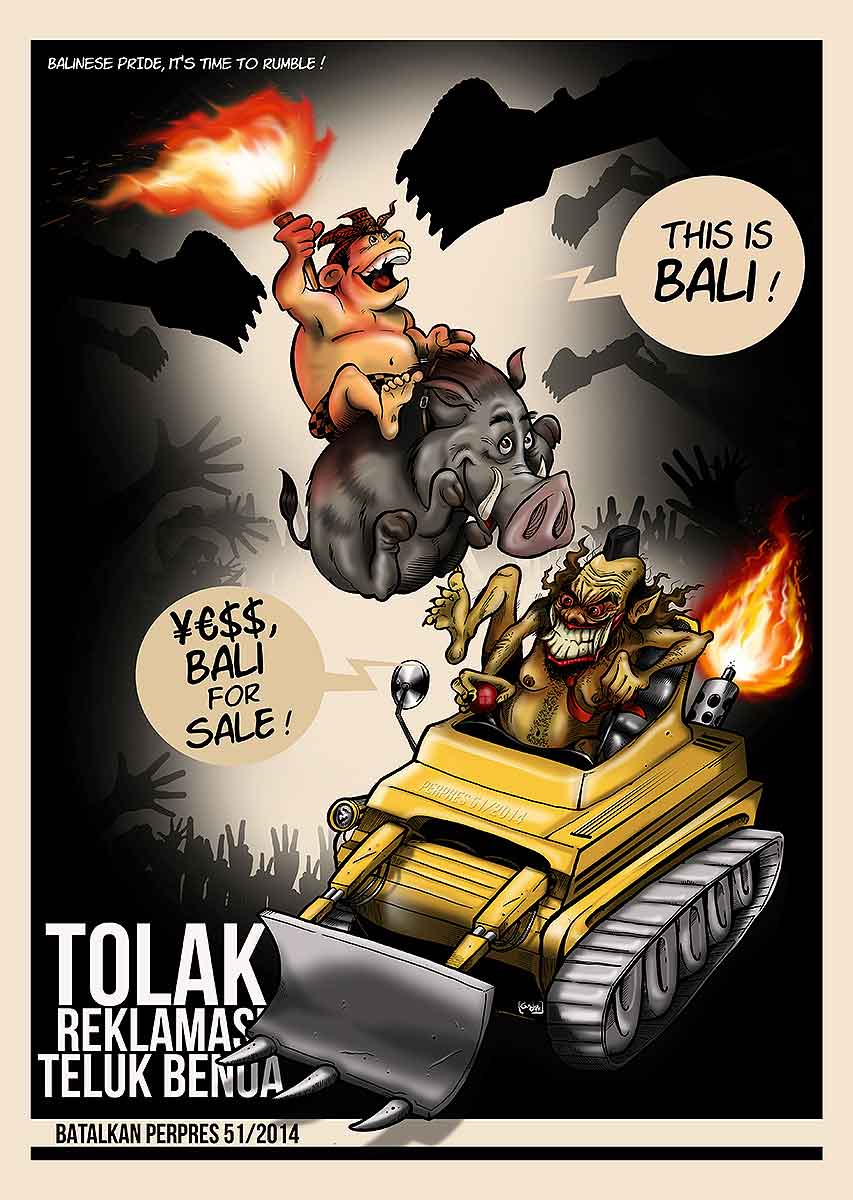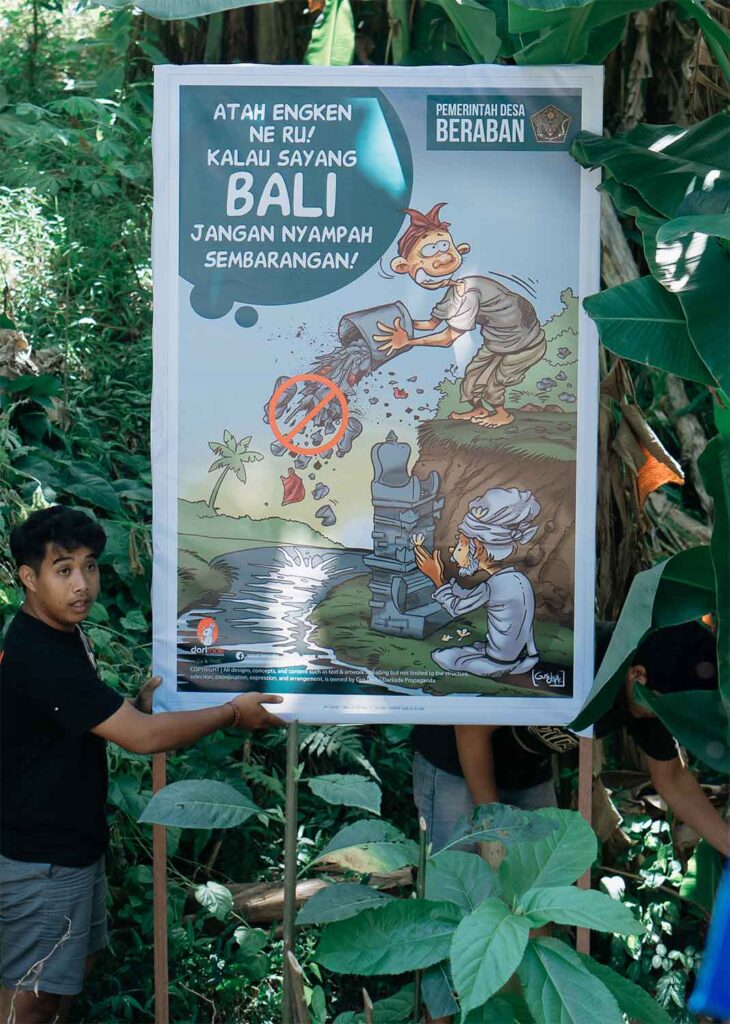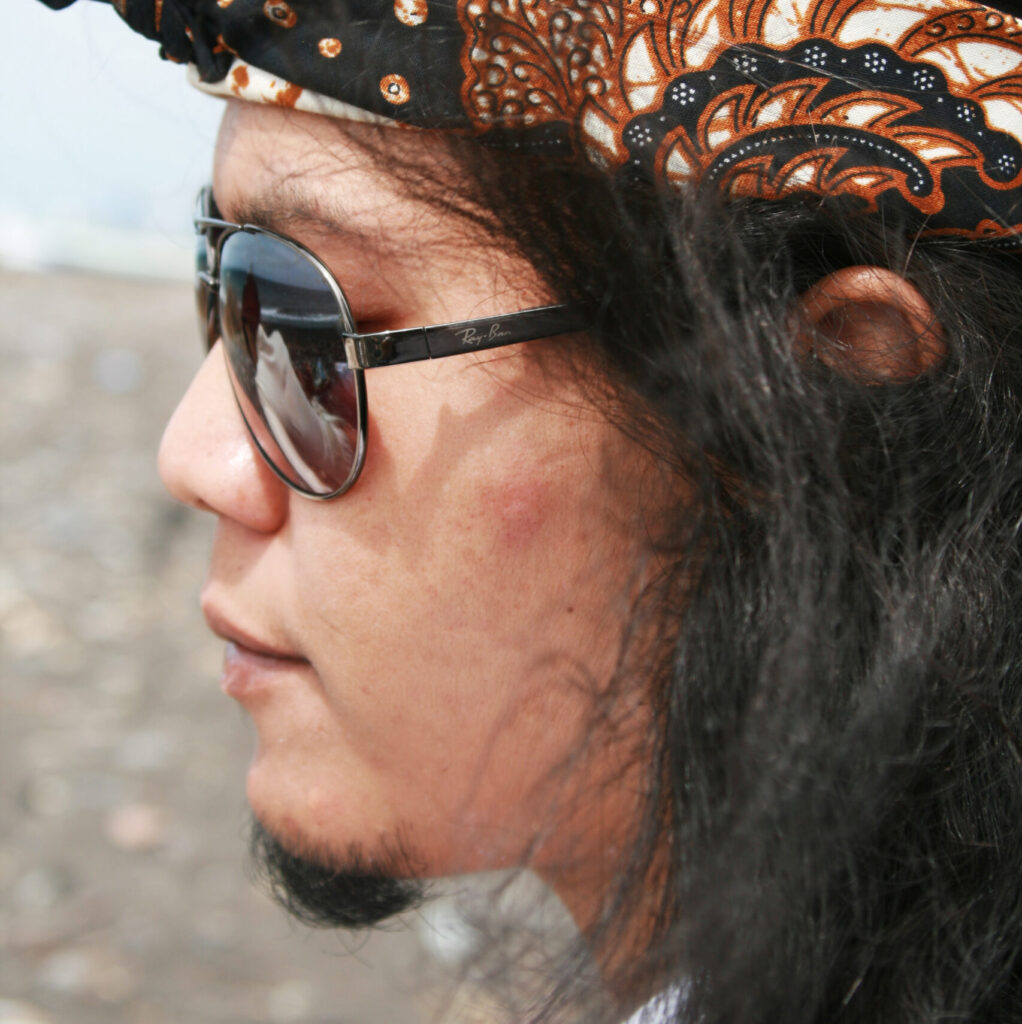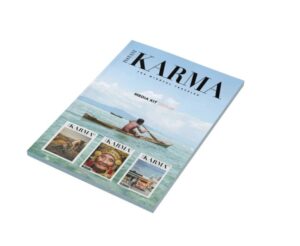Bali’s Talented Visual Artist who Inspires with a blend of Creativity and Activism.
Cartoon illustration is an art form that allows artists to express their ideas, humour and views through humorous, evocative and satirical images. One visual artist who has created works that have inspired and sparked discussion among many is Gus Dark, a talented visual artist from Bali.
Gus Dark was born in east Bali, Karangasem and since childhood, he has had a keen interest in art, especially visual art. A true art lover, Gus Dark decided to pursue his career in illustration. He started his professional journey as an illustrator by working for several local magazines and newspapers in Bali.
One of the things that makes Gus Dark stand out in the cartoon world is his unique signature style. Gus Dark often uses elements of Balinese culture in his work, such as traditional costumes, landscapes, dances, and gamelan, to add a distinctive local touch to his works. His creativity is not limited by geographical boundaries, and Gus Dark’s works often address global issues in a humorous and intelligent way.
Aside from being entertaining, Gus Dark’s works also often raise relevant social issues. He uses his art to spark discussion, critique and build awareness on issues such as the environment, human rights and inequality. In his funny pictures, Gus Dark often conveys important messages that invite people to think and dig deeper into these issues.
Let’s chat with Gus Dark
How did you first become interested in becoming a visual artist, and what motivated you to pursue a career in this field of art?
Actually, like other children, drawing is not part of my dreams, let alone thinking of becoming a professional in this field, drawing is a hobby that I have been pursuing since I was a child because when I was learning to read, my father, besides being an artist, was a teacher, he always drew something first before writing the alphabet below it, in that era books were still expensive items and my father used his own visual methods to attract his children to learn to read. In short, I was more interested in the way he drew, so I imitated his drawing before writing the alphabet.
Fast forward, I started to pursue the art of illustration while working at a newspaper where at that time good and critical drawings were needed to be displayed on the front page with emerging socio-political issues. To get a work that suited the issue, I had to dig into the news, squeeze out the essence and translate it into visual form.
I carry this habit with me until now because I feel that the visuals I create should not be shallow and just baseless outbursts of emotion that can eventually become a source of distress.
As far as I remember, what finally motivated me to pursue this profession was my realisation that visual art can be a weapon to voice an issue, in this case I call it positive propaganda. Under the banner of “Darkade Propaganda” with the tagline “fight through art” I use my ability to spotlight things that are not picked up in mainstream or international media.
What is your signature style of cartooning that reflects Balinese culture and local elements? What makes it so important in your works?
As you can see, I often use the visual character of “örang Bali” in the era before mass tourism. Only wearing a cloth (kamen kancut symbolises bravery) and shirtless. This visual is important to translate that the character I am voicing has no hidden interests, is honest with nothing to hide and is down to earth.
Bali’s cultural elements in this era have become a brand entity, anything labelled Bali will always provoke attention, all global eyes are always on this island, because what happens in Bali will be measured by international parameters.
Therefore, I reverse the situation from the bombardment of exotic Balinese romanticism by feeding the International viewer with my satirical artworks about what currently happens in Bali and Indonesia. Opening the curtain, inviting the viewer to look deeper and trying to give a balanced portion of the social and environmental issues happening in the island and the country.
So that there is no omission in the name of economy, investment and the glittering tourism industry but on the one hand grinding down local life and culture.
Your cartoons often bring the social issues. Can you talk more about how you use visual art/cartoons to voice important social messages?
If we trace history, both in world war 1 and 2 and even now. Propaganda in the form of visuals is always interesting, besides being of high artistic value, visual works are more quickly absorbed by various levels of society. Information presented in visual form can be enjoyed regardless of age, education, social background or economic level.
Visual propaganda has always been the choice of various parties for all interests because of its speed in attracting attention. This made me realise that I have the ability to voice social messages, criticism and awareness for those who are not heard, from the marginalised to the living creatures around us, for example the issue of Balinese dogs, dolphin exploitation and others, of course, by first digging for more in-depth information.
What are your sources of inspiration in creating your cartoons?
Are there any other cartoonists or artists who influence you?
In my journey in the world of illustration, there are certainly many artists and figures who have influenced my work. But that’s okay when you’re still searching for yourself in the visual world.
Once I have found my own style, I try to remain consistent so that at some point my audience can recognise my work without having to search for my signature (laughs).
The source of inspiration for my work is more on social life, culture, nature, issues that develop in the media and the complaints of the people on the streets and social media, all of which are always a never ending source for my creativity.
How was your career journey in cartooning? What are the most memorable experiences or challenges you have faced during this journey?
Like all activists and people who are critical in their behaviour, of course there are times when we will be faced with situations where we have to choose between idealism or compromise. These experiences have sharpened me to be ingenious in order to stay on the independent, critical path without losing my freedom because of the “edge of the cliff” joke considering the many rubber articles that are scattered like mines for those who dare to speak up.
Many memorable experiences throughout my working life, from being able to be in line with people I used to only see through the media to being able to speak out on the national scene (when participating in breaking the MURI / Indonesia World Record Museum record, together with artists) and International even though sometimes it goes without significant support from the local authorities who should be active and protect all the people, the legal owners of this country and taxpayers for the wheels of life.
Do you have your own favourite cartoon works? If so, why is it your favourite?
All my works have always been my favourite because as I said earlier, the process of creation is not always easy. There are various sources of information and data that help the process of its birth. Some works are special because they can touch the hearts of the viewers and move their determination to be part of the struggle, one of which is the series of works “Tolak Reklamasi Teluk Benoa” which eventually spread in various visual forms ranging from t-shirts, posters and billboards on various street corners erected voluntarily by indigenous peoples.
These works are part of the history of social movements in Bali and it makes me proud to join other artists who voluntarily contributed to the biggest movement of the Balinese people in this era.
How do you see the role of Balinese culture in your cartoon art?
I was born and live in an environment where art is a daily activity. This certainly makes Balinese culture an integral part of my work, because Balinese culture that grows and lives in the community is created from the social life of the people themselves. Similarly, my works are born and breathe with the life around them.
Balinese culture, in my view, is the same as its owner, is equally dynamic. It is unbound and evolves with the times. Traditional art can be collaborated with modern art, just as traditional painting can be combined with technological advances. As long as we don’t disrupt the three art spaces set by our ancestors: sacred, semi-sacred, and profane/entertainment, I think Balinese culture with its simple rhythms will always be my source of inspiration.
Are you involved in art education or workshops?
I always make time to participate in workshops and classes at regular events or by invitation. Because I realise that in the short time at school, there is not much time for children to focus on one subject that should balance their brain power, namely art. Sometimes art becomes a “complementary subject” because the teachers appointed to teach it don’t necessarily have the interest and talent to serve the young generation’s thirst for creativity.
Currently, I am trying to provide a light-hearted but useful workshop for their future, namely the “make your own awareness poster” workshop, this workshop aims to make children realise that they also have the ability to share awareness with their own work about the issues around them. This will prevent the children from becoming ignorant, because a country collapses not because of debates or differences in political views but because of ignorance.
What do you hope to achieve through your cartoon works in the future?
My hope for the future is that one day there will be more people who dare to speak out loudly through art and other platforms because we have the right to be critical.
Maybe at the moment my visual activist friends and I are going through a steep rock, but in the future hopefully criticism will be seen as a common thing, one of the pillars of democracy that measures the involvement of every person in this country in overseeing the wheels of government and my work is in the line of historical momentum.
Dreams are always there, they keep us alive. My dream like other artists is of course one, a solo exhibition to voice issues without having to be afraid of unclear legal articles (laughs).
How do you see the role of art, and in particular cartoon art, in bringing about social change and raising public awareness?
As I said at the beginning, visual art in Indonesia is still underestimated, although nowadays there is a collective awareness, but it needs a special environment so that this art becomes an industry that counts and can make a significant change in the lives of people in it, especially the artists themselves.
That’s in the economic field, but if in the social field of cartoons in Indonesia can be seen as a marker of the times, from the cartoons of the independence, revolution and reformation eras we can see the social changes that occurred in the life of our country.
How cartoons in each era have boundaries that adjust to the rhythm of socio-cultural life that prevailed at that time in society, which may no longer exist, disappear or change. Each work has a mission to raise awareness with simple language and an eye-opening sense of art.
Is there any specific message or advice you would like to pass on to young artists who want to follow in your footsteps in the world of cartoon art? 
My message is short, focus and pursue your strokes until you find your identity there and don’t forget to have fun because art is not an exact science, art is an overflow of emotions that arise when creating, without emotion, the art we create will feel empty like the work of Artificial Intelligence. Feel it!
Instagram : @gus_dark_art
Email : gusthebalinese@gmail.com

